Checking ventilation at school: standards and procedures for checking the efficiency of air exchange
Many parents hear children complaining about stuffiness in the classroom and headaches during lessons.The reason for schoolchildren's lethargy and lack of interest in the subject may be not only the difficulty of presenting the material, but also a lack of oxygen. Ensuring effective air exchange is important for maintaining children's immunity, as well as for high brain activity. The child’s psychological comfort during training depends on it.
A timely check of ventilation in a school will help determine the correct operation of the system and the compliance of the air in the room with the standards established by law. And who should conduct it and how often - this is exactly what we will talk about in our article.
The content of the article:
The influence of air exchange on learning performance
It has been scientifically proven that with enough fresh air, students get sick less, behave more actively in class, and remember new material better. And with a lack of oxygen, they feel drowsiness, depression, and irritability.
Since children spend up to 80% of their time in classrooms on weekdays, it is important to create comfortable conditions at school by ensuring effective air exchange.
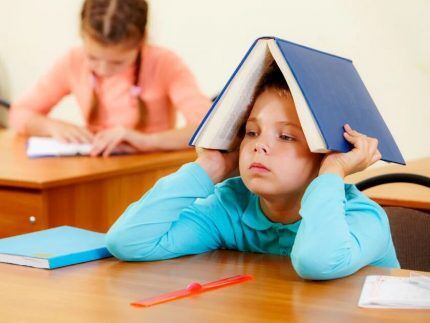
The legislation establishes the frequency of inspection of the school ventilation system, but an annual inspection is not able to provide control over the efficiency of air exchange in changing conditions, for example, when the air temperature outside the window changes after the start of the heating season.
Oxygen delivery may be reduced due to the following factors:
- old school building equipped with an ineffective ventilation system;
- plastic windows without vents, which ensure tightness and do not allow air from the street to pass through;
- outdated ventilation system or its complete absence.
When attributing a child's lethargy to the weather or time of year, one should not forget about the sufficient amount of oxygen that must be supplied to the body. If the ventilation system does not cope with its functions, it is important to ventilate the room during breaks or raise the question of the possibility of equipping windows supply valves.
The main tasks of ventilation in a school
To ensure effective air exchange, decomposition products must be dynamically replaced with portions of fresh air without reducing the temperature in the room. Open windows in winter cannot cope with such a task. Hot children entering ventilated classrooms will catch a cold.
The school should provide comfort during learning and be safe. Exhaust air often enters through a corridor or door. This type of intake is considered one-time, since the amount of outgoing air corresponds to the volume of incoming air.
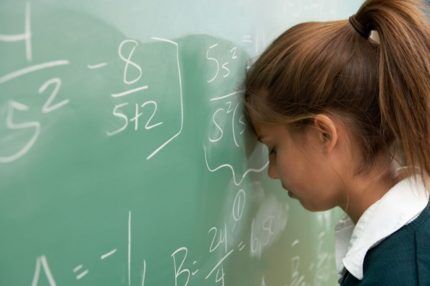
In accordance with the requirements of sanitary regulations, air exchange in ordinary classrooms is allowed using natural ventilation. Higher demands are placed on physics and chemistry classrooms, workshops, and gyms.
Air exchange standards in classrooms
When checking the ventilation system in a school, the efficiency of air exchange, regulated SNiP 41-01-2003, SNiP II-65-73.
The main criteria by which the effectiveness of ventilation is assessed include:
- Air quality — a sufficient volume of purified air masses with a low carbon dioxide content will allow teachers and students to concentrate on the learning process.
- Air exchange rate — since students move little during training, promptly replacing decay products with clean air will allow them to feel good.
- Noise level — ventilation should not only provide effective air exchange, but also not create a lot of noise during operation.
A feature of schools and other educational institutions is the presence of classrooms with different purposes. Educational classrooms, chemistry classrooms, gyms, teaching rooms, and catering facilities have individual air exchange standards.
In addition to different purposes, during the educational process the premises differ in occupancy, therefore, in order to comply with the recommended standards, efforts are required to ensure constant monitoring of the technical condition of the system.
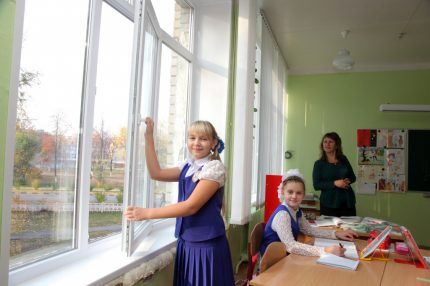
To check the ventilation system and determine its effectiveness, the following indicators of the Sanitary Rules are taken as a basis:
- air exchange standards for classrooms, laboratories - at least 16 cubic meters per hour heated air (per student), for gyms - 80 cubic meters per hour per person;
- temperature regime in classrooms should be within the range of - 18 - 22 ° C;
- carbon dioxide concentration should not exceed 800 – 1,000 ppm;
- noise level limitgenerated by ventilation should not exceed 110 dB.
In laboratory rooms, the air is polluted not only by human activity, but also by harmful substances that are formed as a result of chemical reactions. Therefore, laboratories must be equipped with forced-air systems, and the air from them must be removed through a special ventilation cabinet.
The bathroom must also be provided with an additional volume of forced air, which, in accordance with sanitary requirements, must be:
- 25 cubic meters per hour for each urinal;
- 50 cubic meters per hour for each toilet.
The air supply is carried out under the ceiling in rooms of standard height, and in gyms - at a height of at least 2 meters from the floor. Compliance with the rules will help avoid drafts.
Features of ventilation testing
Determination of the efficiency of the ventilation system is carried out by accredited organizations using high-tech equipment. After the inspection is completed, calculations are carried out, on the basis of which an expert opinion is issued.
During the survey, the results obtained are compared with regulatory requirements. Moreover, not only the efficiency of air exchange is assessed, but also its frequency.
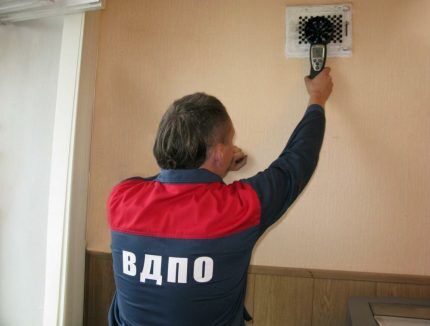
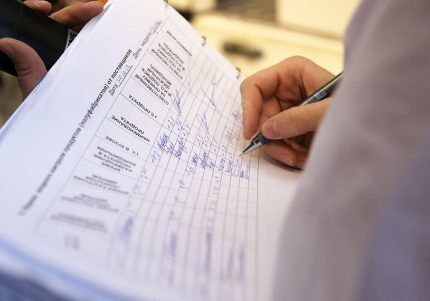
If deviations are identified during the verification process, professionals provide recommendations for debugging the system. Rostechnadzor checks the documentation. If deficiencies are discovered, the administration of the educational institution will face penalties.
The frequency and timing of inspections, as well as the standards, are established by sanitary standards:
- the use of the ventilation system is permitted after commissioning and receipt of technical passports;
- SanPin regulates the frequency of inspection at least once a year or upon delivery of the facility, and in schools the ventilation system is checked before the start of the school year;
- natural, general exchange networks are checked at least once every 3 years.
The above standards are relevant for ventilation that works correctly.
When commissioning work was not carried out or was carried out incorrectly, ventilation systems often operate with reduced efficiency.
Conclusions and useful video on the topic
A school is a rather complex object; its features are important to take into account when arranging ventilation. Five useful tips offered by professionals in the video will help ensure effective air exchange and a healthy atmosphere in classrooms:
When air exchange is organized correctly, there will be no problems with ventilation checks at school. However, not every educational institution has the opportunity to modernize the system.Many structures are decades old, and updating equipment requires considerable funds.
If you have a positive experience solving a problem, share it in the comments. Also below, under this publication, you can ask questions to our experts and other site visitors on the topic of the article, ask for advice or express your opinion.



